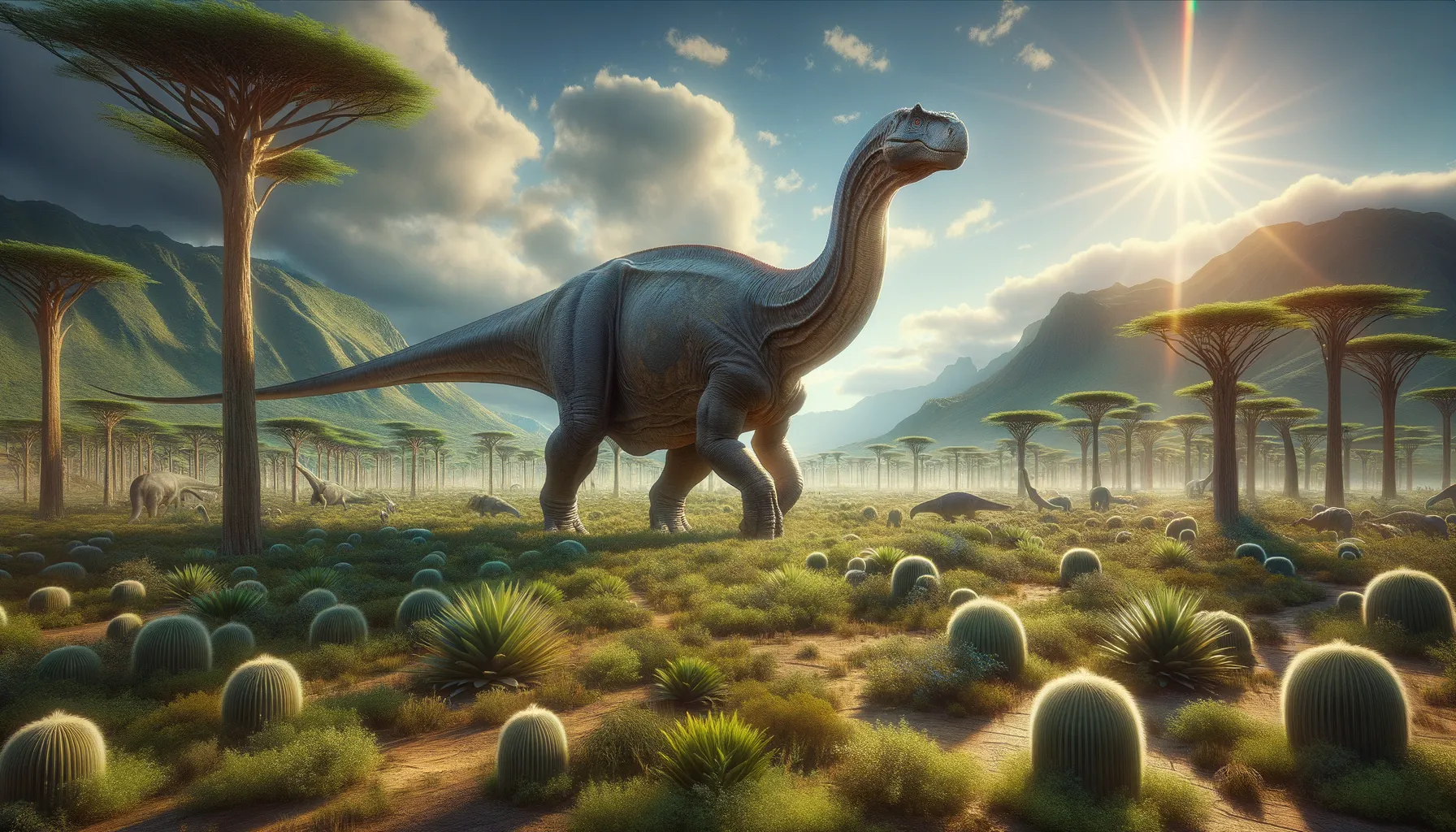
Atlasaurus
Giant among Jurassic giants!
Period
Jurassic
Length
Measured about 15 meters in length.
Height
Reaching up to 10 meters tall.
Weight
Weighed around 22 tons.
Atlasaurus was a sauropod dinosaur that lived during the Jurassic period, primarily found in what is now North Africa. Its long neck and tail, combined with a massive body, made it one of the largest animals of its time. Despite its size, this herbivore had a relatively short neck compared to other sauropods. Its unique skeletal structure provides valuable insights into the diversity and evolution of sauropods.
Diet
Atlasaurus was a herbivore, feeding primarily on leaves from tall conifer trees. The structure of its teeth indicates it was well-adapted to stripping foliage from branches. Its height and long neck allowed it to reach vegetation inaccessible to smaller herbivores.
Hunting
As a plant-eater, Atlasaurus did not hunt for food. It relied on its size as a defense mechanism against predators that could threaten its safety. Its daily activities would include foraging among the high branches of trees.
Environmental challenges
During its time, Atlasaurus faced environmental challenges such as climate fluctuations that could affect the availability of plant-based food sources. Competition with other large herbivores was another challenge, as several sauropod species coexisted in the same habitats. Navigating through dense forests and open plains required adaptations in locomotion and feeding strategies. Seasonal changes could lead to migration in search of food and water, influencing its survival and distribution.
Speed
Atlasaurus was a slow-moving dinosaur.
Lifespan
Estimated to live around 70 years.
First discovery
First discovered in the 1990s in Morocco.
Fun Facts
- Atlasaurus lived around 165 million years ago during the Middle Jurassic period.
- It was discovered in the Atlas Mountains of Morocco, which is how it got its name.
- Atlasaurus was a massive dinosaur, estimated to be about 15 meters long.
- Unlike its relatives, Atlasaurus had relatively longer legs, suggesting it might have been a faster walker.
- It is known for having a long neck, which helped it reach higher vegetation for feeding.
- Atlasaurus is part of a group known as sauropods, which were some of the largest animals to ever walk the Earth.
- The discovery of Atlasaurus gave scientists new insights into the diversity of sauropods in North Africa.
Growth and Development
Atlasaurus, like other sauropods, likely experienced significant growth spurts during its early years. This rapid growth was necessary for survival, as reaching a large size quickly would deter most predators. Fossil evidence suggests a long maturation period, with full size reached in late adolescence. Developing strong bones and muscles was crucial for supporting its massive body weight over its lifetime.
Habitat
Atlasaurus inhabited a variety of environments, including semi-arid regions and dense forests in what is now North Africa. Its physical adaptations, like a long neck, allowed it to thrive in open woodland areas where tall trees provided food. Water sources were essential for hydration, and fossil records suggest it lived near rivers or lakes. Seasonal migrations might have occurred in response to climatic changes affecting resource availability.
Interaction with other species
Atlasaurus shared its habitat with other herbivorous dinosaurs and potentially large predators. Its size likely discouraged many would-be attackers, though young or weakened individuals may have been vulnerable. Interaction with other herbivores included competition for food resources, which influenced its grazing habits. It may have coexisted peacefully with dinosaurs that occupied different ecological niches or relied on other forms of plant matter.
Natural lifespan
Atlasaurus had a natural lifespan of approximately 70 years.
Reproduction
Atlasaurus reproduced by laying eggs, which were likely buried in soft soil or covered with vegetation for protection. A single clutch could contain several eggs, reflecting the strategy of producing multiple offspring to ensure survival. Young Atlasaurus would have been vulnerable to predation, relying on rapid growth and group protection to reach maturity. Parenting behaviors in sauropods are still subject to research, though some level of care for hatchlings was likely.
Social behaviour
Atlasaurus may have lived in herds or loosely organized groups, which provided protection and facilitated social behaviors. Herd living might have helped in resource location and increasing reproductive success through social interaction. Communication amongst individuals could involve vocalizations or visual signals, particularly during the breeding season. Cooperation among members strengthened the group's defense against potential predators.
Fossil locations
Fossil remains of Atlasaurus have been predominantly found in the Middle Jurassic strata of North Africa, specifically in Morocco. These discoveries provide key insights into the diversity of Jurassic sauropods in Gondwana. The well-preserved fossils allow researchers to study the evolutionary relationships among sauropods from different regions. Continued exploration in these areas might yield more specimens, deepening our understanding of their distribution and lifestyle.
